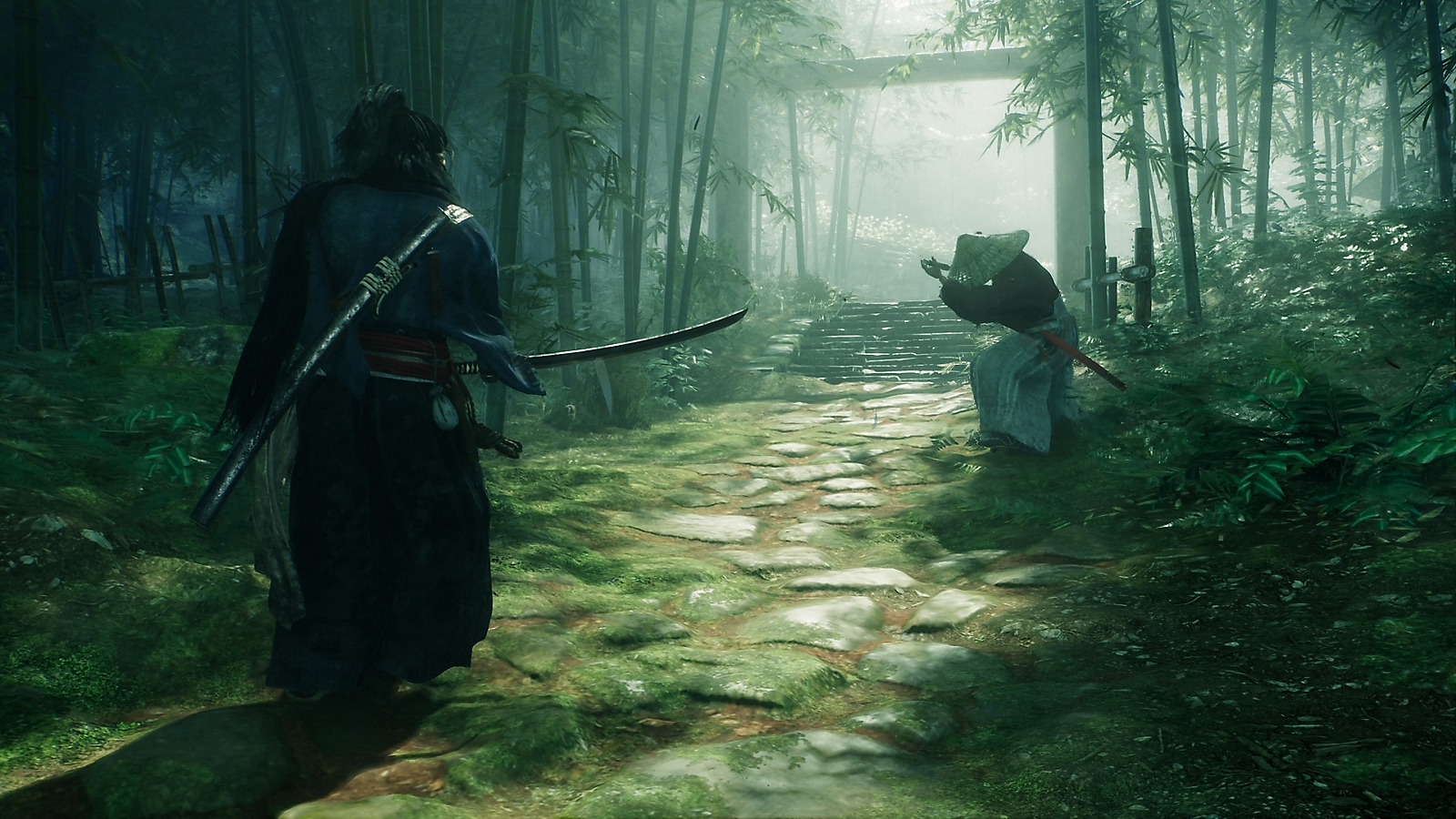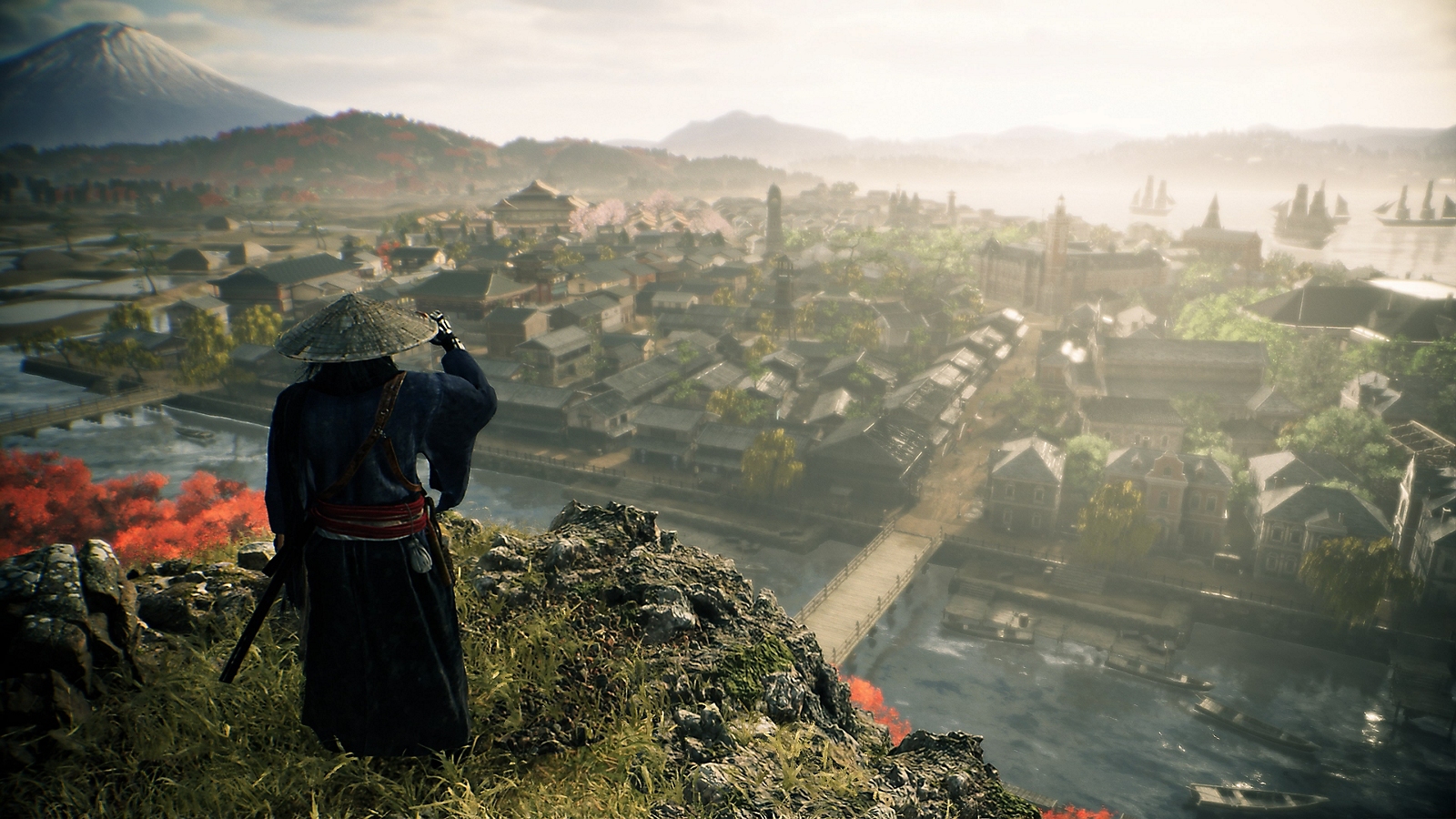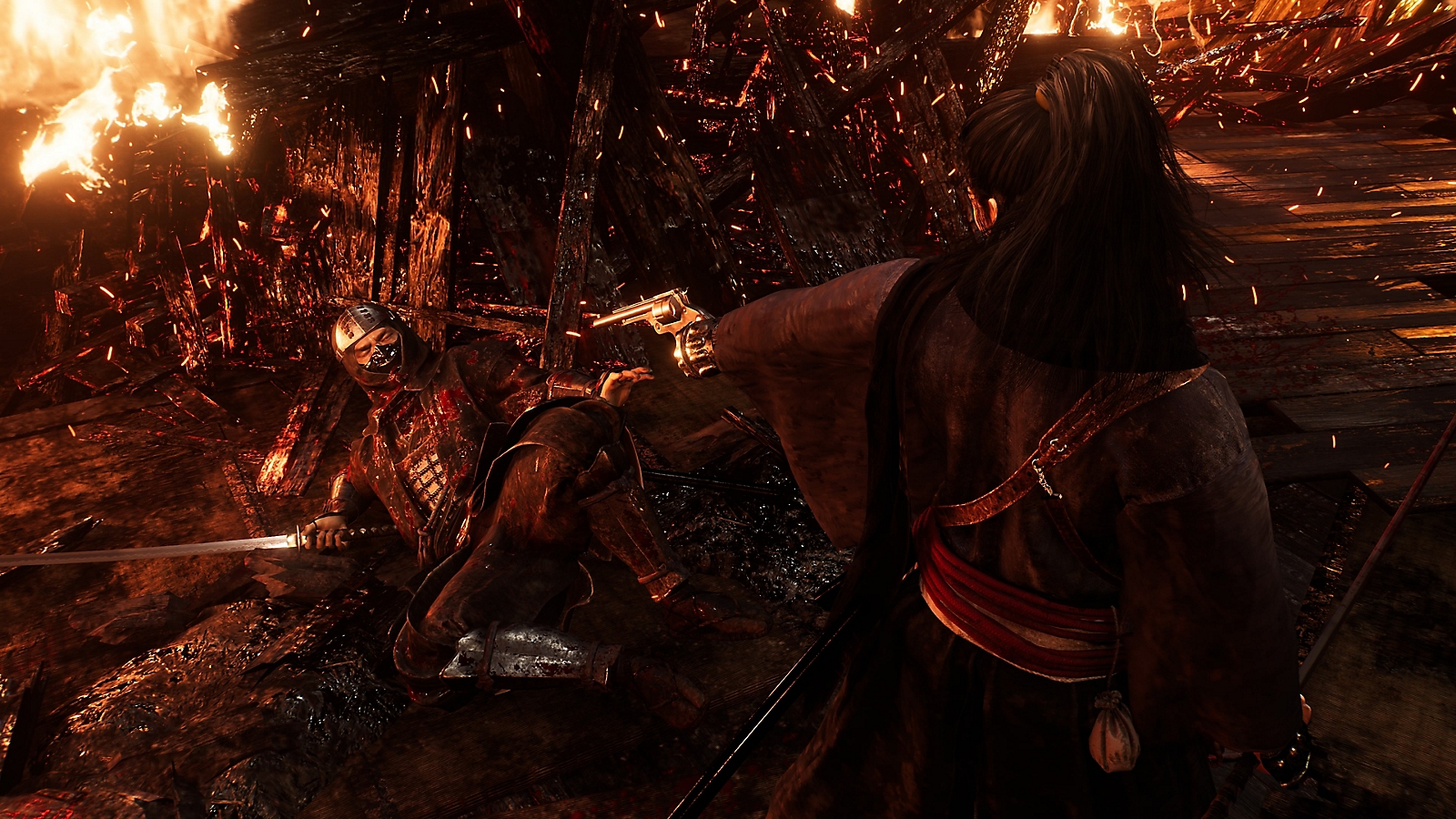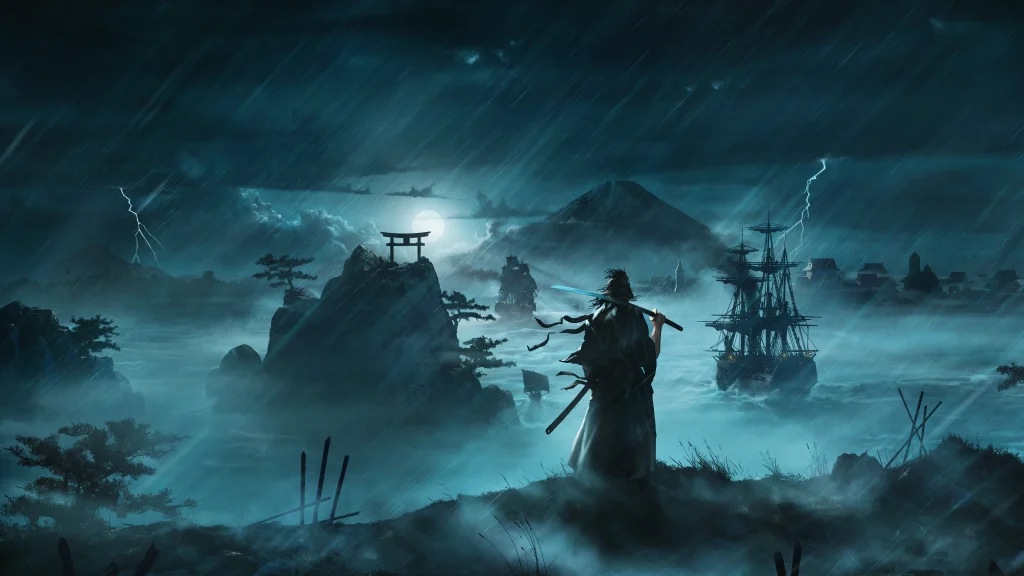Rise of the Ronin is, easily, Team Ninja’s most ambitious game yet. An open-world mash-up of Tenchu-ish stealth and Nioh-flavoured combat. A comprehensive (if romanticised) retelling of the full breadth of Japan’s tumultuous bakumatsu era—the final days of the samurai—and its many fascinating sociopoliticial complexities. A beautiful, authentic recreation of Japan at a time of major upheaval, spanning three fully-realised maps. There are times when Ronin feels a little too ambitious, when a bit more focus and restraint would be better served. But for the most part, it masterfully executes on its vision, creating an engrossing rendition of a particularly intriguing slice of not-so-ancient history.
A time of change
It starts in 1853, with the arrival of Commodore Matthew Perry (no relation to the actor) and the forced opening of Japan’s borders after a couple hundred years of near-complete isolation. Off the back of dissatisfaction with the ruling Tokugawa shogunate that had already been brewing for a long time, this show of impotence in the face of Western powers sparked the flames of rebellion and bloody, violent revolution.
Against that backdrop, Rise of the Ronin casts you as a member of a hidden clan with a vendetta against the shogunate. Your first mission? Sneak aboard one of the Black Ships and assassinate Commodore Perry. (Any game that opens with a quest to kill Perry is a good one, in my book.) When that doesn’t quite go to plan, you find yourself embroiled in a fight for Japan’s future, rubbing shoulders with historical figures like Sakamoto Ryoma and the Shinsengumi.

One of the most interesting things about the bakumatsu period is the fact that, despite conflicting ideals taken to violent extremes, everyone is driven by a similar purpose. Everyone wants what they think is best for Japan at a time of unprecedented social, political, and technological change, but views on what that looks like and how to get there. Rise of the Ronin goes to great lengths to show those different perspectives, with a story that sees you working alongside both pro- and anti-shogunate forces at different points. At a few key moments, you’ll have to choose a side, with certain missions and plot points unfolding differently depending on who you ally with—especially towards the end of the game—but for the most part, you’re something of a neutral party, allegiances driven by the ebb and flow of a linear, authored narrative.
A battle of ideals
This is where Rise of the Ronin starts to buckle under the weight of its ambitions. It wants to be both a directed, focused story and an open, player-driven one, and some impact is lost in the attempt to be both. It’s jarring to side with the pro-shogunate forces whenever there’s a choice (I’m a Shinsengumi fanboy, what can I say), only to suddenly be working with revolutionaries because a main story mission demands it… with no impact on one’s standing with either faction.
Disjointed though they are, such moments are fleeting in the broader scheme of things: a detailed and nuanced yet wildly entertaining account of the period, from start to finish—from Perry’s arrival in 1853 to the Meiji Restoration and Boshin War, 1868. While it broadly follows real-world history and timelines for key events, it’s not overly beholden to historical accuracy when you get into the weeds—it’s an entertainment product, not a textbook. Historical authenticity, on the other hand, is a major focus, as the game goes to great lengths to capture the mood of the time, the intricacies of the many different societal factors at play, and the motivations of people involved. It’s a romanticised account, absolutely, but a genuine one at the same, which makes for a fascinating, exciting, and thought-provoking journey no matter how familiar (or not) you are with the history being depicted. (Fellow bakumatsu nerds are in for an extra treat, though, with plenty of easter eggs and colourful portrayals of familiar faces.)

It’s not just the major events and set pieces, either; the bonds you form with those various historical figures show a more personal side of the conflict. Mechanically, there’s nothing here to break from the well-worn path of relationship systems in RPGs: gifts and character-centric side quests help strengthen your friendship (or more), which in turn leads to characters opening up more about personal circumstances. But a lack of innovation doesn’t make the system any less effective at introducing different perspectives and shedding light on the many, many different factors that were all coming to a head at such a tumultuous time.
A world in chaos
That authentic feeling is bolstered by Rise of the Ronin’s open-world design, which does an impressive job of establishing a sense of place. The game spans three maps—Yokohama, Edo (modern-day Tokyo), and Kyoto—that aren’t especially huge but are meticulously crafted. (That in itself feels like a novelty, when the prevailing ethos for open-world games is seemingly “make it bigger and more filled with stuff”.) Attention to detail in everything from the topography of the landscape to the architecture to the architectural trends of different regions builds a lifelike, compelling image of each location. Well-known landmarks like Kiyomizudera temple in Kyoto are reconstructed in painstaking detail, as are those that aren’t around any longer but are well recorded in historical records, like Edo’s famous Yoshiwara red light district.
More to the point, the design of the maps captures a snapshot of a world in a state of flux and upheaval. In Yokohama, you’ll find traditional Japanese buildings alongside freshly-built Western-style districts and Japan’s first Chinatown, with numerous farming hamlets on the outskirts. The opulent, imposing Edo Castle is surrounded by the hustle and bustle of the country’s most populous city, decrepit slums, and villages decimated by the spread of cholera, the inequalities of the shogunate’s rigid class system on full display. Kyoto, the imperial capital, is both a site of rich history and a warzone, ravaged by the violent actions of anti-shogunate and pro-shogunate forces alike.

Exploring these locations is awe-inspiring and humbling by equal measure. An assortment of open-world activities act as breadcrumbs to encourage exploration, adding texture to the world in the process. Some of the activities can feel a little uninspired; icons on a map to check off for the sake of finishing a to-do list, but the inherent richness of the world makes this a mild annoyance at worst. The more meaningful ones more than make up for it: visits to significant landmarks, photography challenges involving noteworthy locations, and local quests that help tell the story of what life was like for regular folks in this time.
The joy of exploration is kicked up a notch with a grappling hook and the Avincula, Rise of the Ronin’s take on a glider that’s increasingly becoming a staple of open-world games. They do little to deviate from established formulas, but make for fun ways of getting around all the same, especially in a setting with plenty of mountains and towering pagodas to launch from.
A clash of steel
It’s a little odd to be several hundred words into a review of a Team Ninja game without any mention of action. In part, that reflects a shift in the studio’s focus with Rise of the Ronin, away from linear, action-centric games like Ninja Gaiden and Nioh to a more open affair with a focus on exploration and discovery. But that’s not to say Team Ninja’s roots can’t be found in Ronin, with intense combat still being a central pillar of this game’s design.
At its core is something not unlike Nioh: melee combat designed around stamina (ki) management, but that encourages an aggressive approach through risky but effective ways of recovering ki and pressing the advantage. Well-timed parries are key to gaining the upper hand, as is switching between stances that offer advantages over different weapons.

But where Nioh mostly demands a methodical approach, Rise of the Ronin leaves room for a bit more improvisation and playful chaos. Some of that comes down to gadgets like the fire pipe (and old timey flamethrower) and combat applications for the trusty grappling hook, some of it comes down to the wide array of weapon types and combat styles you can learn, each offering vastly different attack rhythms, movement, and special techniques. But most of all, it’s down to the game’s open structure that makes direct, head-to-head combat largely optional outside of boss fights.
Whether through ghostlike sneaking or misdirection by way of gadgets and environmental hazards, stealth plays a big role in Rise of the Ronin. Many enemies can be killed instantly with a stealth kill; more powerful ones will survive but still take heavy damage, making the ensuing fight much easier. Even then, a sequence of hit and run sneak attacks is often a viable option. This is as true for linear story missions as for the open world, too: almost every mission is designed to make stealth an effective style of play, and at its best, Ronin feels like the closest we’ve had to a new Tenchu game in years.
By that token, Rise of the Ronin is also a much more forgiving game than Nioh, if you want it to be. And not just because of the way it accommodates a stealth-first approach, but with difficulty settings and optional gameplay assists—in a “soulslike”! Most story missions let you bring along AI companions if you want, which gives another avenue to tweak difficulty. Anyone wanting a bigger challenge can have their fill, too, especially with the “Midnight” difficulty that unlocks after completing the game…

Nioh’s overabundant loot system, meanwhile, is something Ronin could have done without. You’ll see hundreds—thousands, even—of pieces of gear drop over the course of the game, and you’ll sell or disassemble most of them. Random stat bonuses that are both extremely specific and miniscule in effect are the main thing differentiating one sword or helmet from another, which makes the whole thing feel aimless. That’s true enough of Nioh itself, but even more the case here, where the dynamic design of us combat makes the minutiae of secondary stat management feel like much less of a factor. Rise of the Ronin would have been much better off doing away with that whole system in favour of rarer but more significant equipment upgrades.
* * *
Concessions like “loot is annoying” and “some open world activities are underbaked” are tiny complaints in the big picture, though. Rise of the Ronin more than delivers on its lofty ambitions, seamlessly blending the intense combat Team Ninja is known for with a stealthy touch reminiscent of classic Tenchu and an open world that serves a more meaningful purpose than just saddling players with stuff to do. Rather, it’s an open world that helps tell one of the most comprehensive and detailed accounts of the bakumatsu era you’ll find in any work of fiction. Is it dramatised and romanticised? Without a doubt, but that makes it no less authentic in how it traverses the social, political, and personal intricacies of one of the most intriguing periods of semi-recent history. That’s perhaps where Rise of the Ronin is at its most ambitious, and the way Team Ninja delivered on such ambition is nothing short of masterful.
Reviewed on PlayStation 5 with a review code provided by the publisher.
Team Ninja takes on—and rises to—it's most ambitious challenge to date with Rise of the Ronin, as Nioh-style combat, Tenchu-like stealth, and open-world exploration come together for an engrossing journey through one of the most fascinating periods of Japan's history.

